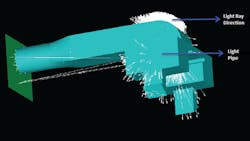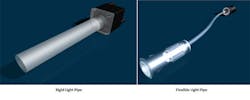Download this article in .PDF format
A LED light pipe is an optical fiber or a solid transparent plastic rod for transmitting light from an LED mounted on a printed circuit board (PCB) to the user interface. Light pipes transmit up to 80% of emitted light with excellent visual performance, making them viable for a broad range of applications. LED light pipes offer uniform illumination, reduced shadowing and glare, design flexibility, easy installation and multiple product format and packaging options.
There are a wide variety of standard LED light pipes on the market today. In addition, new developments in 3D CAD/CAM modeling, ray tracing and rapid prototyping have led to a large and growing demand for custom LED light pipe technology. Custom light pipes can now be less expensive, more efficient and speed time to market compared to their off-the-shelf counterparts. A quick overview of emerging LED light pipe technologies can help design engineers optimize performance and cut costs.
Table of Contents
- Light Pipe Options
- What Is The Best Light Pipe For An Application?
- Light Pipe Matching
- Ray Tracing For LED Light Pipe Applications
- Standard Vs. Custom LED Light Pipes
There are two basic styles of LED light pipes – rigid and flexible (Fig. 1). A rigid light pipe is produced with a hard plastic material and will have either a vertical or a right-angle construction, capable of redirecting the LED’s light output to the desired location with minimal loss of intensity. Rigid light pipes are ideal if the LED is mounted on a board immediately behind a front panel.
Flexible light pipes are constructed with an optical grade plastic material that provides less rigidity allowing them to transport light from a board at custom, user-specified subtle angles ensuring easy integration around existing components. Both rigid and flexible light pipes can come in single or multi-unit configurations.
There are two basic formats of light pipes: vertical and right angle. Within both styles, the light pipe can either be a single unit or multiple unit and designed to a variety of shapes, including round or rectangular. A quality multi-unit light pipe will be designed to ensure there is no light bleed between adjacent light pipes
There are several construction options as well. Some to consider are: polycarbonate or optical grade materials; different shapes and lens caps; compatibility with either surface-mount or through-hole LEDs; and panel or PCB mounted.
Related Articles
• Light Pipes Thwart Water
• Light Pipes Offer Many Features
• Master The Fundamentals Of LED Illumination
What Is The Best Light Pipe For An Application?
A quality LED light pipe supplier will provide expert complimentary selection and integration support. They should ask questions like: Where is the light source coming from? How far back is the LED from the emitting source? What LED are you considering for the design? How much brightness is required? What amount of real estate is available to work with? Can the light be effectively routed in a right-angled application? What are the mounting considerations, i.e. friction or snap fit? What is in the path of the light transmission? Can the design provide uniform light performance?
Generally speaking, the brightness emitted from a light pipe will be dependent upon the LED utilized, as well as the shape of the application. A properly matched light pipe will emit approximately the same brightness as the individual LED, minimizing the amount of light lost. An LED must be effectively matched to the entrance of a light pipe in order to allow for proper light capture with minimal light loss. Effective light pipe and LED matching occur only when the LED radiation pattern angle matches the acceptance pattern angle of the light pipe.
The most effective light pipe and LED matching occurs when the LED is located inside the light pipe surface. When the LED is embedded into the light pipe, 92% of the light rays emanate within the light pipe, allowing for minimal light loss.
Ray Tracing For LED Light Pipe Applications
Ray Tracing is a method for calculating the path of light through a light pipe (Fig. 2). State-of-the-art ray trace software with precise 3D CAD/CAM models can ensure proper design and optimal light transmittance, with minimal light lossvia a three-step process.
First, a three dimensional model, representing an original design concept of a light pipe is created using 3D CAD software to scale. This model is an accumulation of the physical dynamic of a specific light pipe application (including any bends, angles and material for light transmission).
Secondly, an artificial LED is created, called an emitting disc, within the ray tracing program. The emitting disc simulates the intensity and the viewing angle of an LED, which is placed on the surface of a light pipe model. The detector plane is created in front of a surface where the light is intended to exit. The combination of these two planes in the ray trace program determines the amount of light transfer from LED to the emitting surface of a light pipe.
Finally, with a precise 3D model and proper LED viewing angle, it is then possible to run the design through cutting-edge ray tracing technology to test the exact light output in terms of both uniformity and brightness. By measuring this light output via ray tracing, adjustments can be made to ensure that the most efficient light transmission path is identified and tested before any time or expenses are spent on tooling.
Ray tracing provides several key advantages for LED light pipe applications. First, precise product modeling ensures the most efficient possible design – providing maximum light transmissions and minimal light loss. Second, because ray tracing calculates optimal design for efficient performance before product tooling even takes place, time wasted on trial and error development is eliminated. This speeds time to market, enabling products to be developed up to 35% faster than is possible with traditional product design techniques. Also, the ability to ensure optimal design prior to product tooling, eliminates or reduces the expense on re-tooling and can generate up to 40% cost savings.
Standard Vs. Custom LED Light Pipes
LED light pipes, be they custom or standard technologies, are a cost-effective and highly efficient tool for transporting light to the user interface. Quality suppliers will have a wide array of standard light pipe technologies—single or array, molded or flexible, single or multi-color formats with right angle, vertical or horizontal packaging for either panel or PCB mounting. At the same time, exciting recent developments in ray tracing technology means that custom light pipes can be created for optimal performance in each unique application with great ease. Gone are the days when custom meant “expensive” and “slow.” Today custom light pipe technology optimizes performance and can generate significant cost savings and speed time to market.



